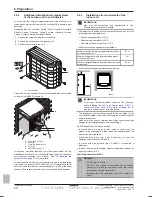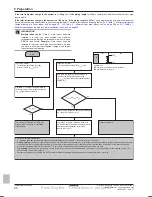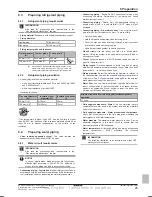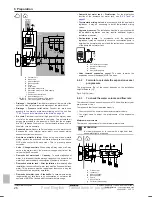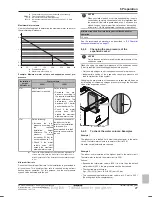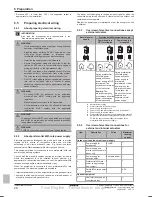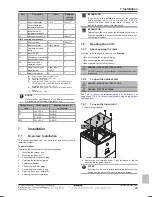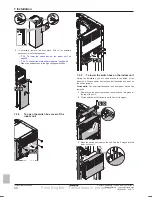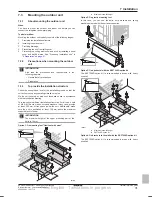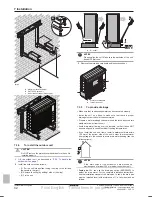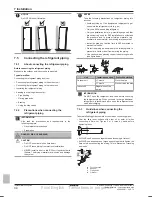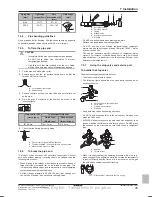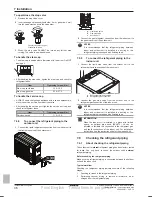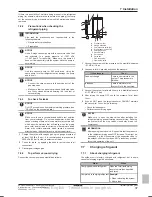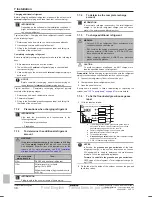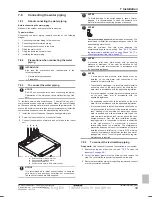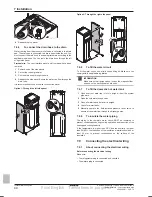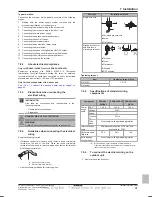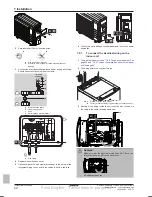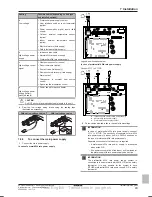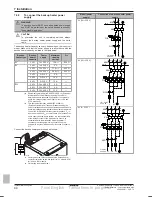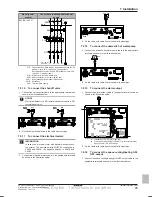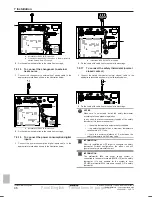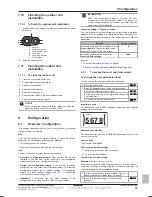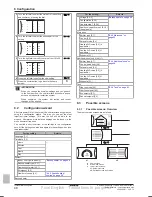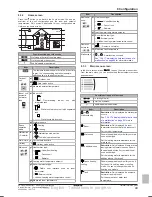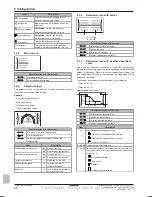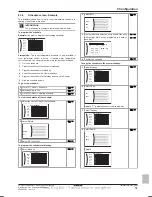
7 Installation
Installer reference guide
36
ERGA04~08DAV3(A) + EHVH/X04+08S18+23DA
Daikin Altherma – Low temperature split
4P495248-1 – 2017.12
To open/close the stop valve
1
Remove the stop valve cover.
2
Insert a hexagonal wrench (liquid side: 4 mm, gas side: 4 mm)
into the valve stem and turn the valve stem:
Counterclockwise to open.
Clockwise to close.
3
When the stop valve CANNOT be turned any further, stop
turning. The valve is now open/closed.
To handle the stem cap
▪ The stem cap is sealed where indicated with the arrow. Do NOT
damage it.
▪ After handling the stop valve, tighten the stem cap, and check for
refrigerant leaks.
Item
Tightening torque (N∙m)
Stem cap, liquid side
13.5~16.5
Stem cap, gas side
22.5~27.5
To handle the service cap
▪ ALWAYS use a charge hose equipped with a valve depressor pin,
since the service port is a Schrader type valve.
▪ After handling the service port, tighten the service port cap, and
check for refrigerant leaks.
Item
Tightening torque (N∙m)
Service port cap
11.5~13.9
7.5.8
To connect the refrigerant piping to the
outdoor unit
1
Connect the liquid refrigerant connection from the indoor unit to
the liquid stop valve of the outdoor unit.
1×
a
b
c
a
Liquid stop valve
b
Gas stop valve
c
Service port
2
Connect the gas refrigerant connection from the indoor unit to
the gas stop valve of the outdoor unit.
NOTICE
It is recommended that the refrigerant piping between
indoor and outdoor unit is installed in a ducting or the
refrigerant piping is wrapped with finishing tape.
7.5.9
To connect the refrigerant piping to the
indoor unit
1
Connect the liquid stop valve from the outdoor unit to the
refrigerant liquid connection of the indoor unit.
b
a
a
Refrigerant liquid connection
b
Refrigerant gas connection
2
Connect the gas stop valve from the outdoor unit to the
refrigerant gas connection of the indoor unit.
NOTICE
It is recommended that the refrigerant piping between
indoor and outdoor unit is installed in a ducting or the
refrigerant piping is wrapped with finishing tape.
INFORMATION
When the indoor unit is installed in a place with limited
space, an optional pipe bend (EKHVTC) kit can be
installed to facilitate the connection to the refrigerant gas
and liquid connections of the indoor unit. For installation
instructions, see the instruction sheet of the pipe bend kit.
7.6
Checking the refrigerant piping
7.6.1
About checking the refrigerant piping
The outdoor unit's
internal
refrigerant piping has been factory tested
for leaks. You only have to check the outdoor unit's
external
refrigerant piping.
Before checking the refrigerant piping
Make sure the refrigerant piping is connected between the outdoor
unit and the indoor unit.
Typical workflow
Checking the refrigerant piping typically consists of the following
stages:
1
Checking for leaks in the refrigerant piping.
2
Performing vacuum drying to remove all moisture, air or
nitrogen from the refrigerant piping.
Final English - Tanslations in progress

